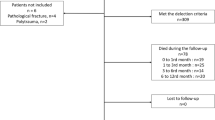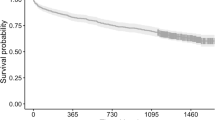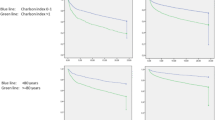Abstract
Objectives
Hip fracture is one of the most common public health problems with a significant financial burden on the patient and on the healthcare system. This study was conducted to assess the 3-month and 1-year mortality rates of patients with operated hip fractures and to determine the influence of predictors of mortality.
Methods
In this prospective cross-sectional study, all admitted patients aged more than 50 years with hip fracture at Chamran Hospital from January 2008 to August 2013 were enrolled. The characteristic data obtained included demographic information, body mass index (BMI), smoking, any previous history of osteoporotic fracture, and comorbidities. In addition, the mechanism of fracture, fracture type, and treatment method were recorded. A follow-up with the patients was conducted at 3 months and 1 year through a telephonic interview to ask about possible mortalities. Statistical analyses were performed using SPSS software version 17.0 for Windows.
Results
A total of 1015 patients aged 50 years and older with hip fracture underwent surgery. Only 724 patients (71.3 %) completed the survey and the 1-year follow-up interview. The mean age was 75.7 ± 10.6 years. Overall, the 3-month and 1-year mortality rates were 14.5 and 22.4 %, respectively. Multivariate logistic regression analysis recognized age (OR 1.08; 95 % CI 1.05, 1.11, p < 0.001), BMI (OR 0.88; 95 % CI 0.82, 0.96, p = 0.003), and smoking (OR 1.76; 95 % CI 1.05, 2.96, p = 0.03) as major independent risk factors for mortality.
Conclusion
It is clear that modifiable factors like quitting the habit of smoking and gaining more energy with better nutrition could reduce the mortality rate if hip fracture occurs in the elderly.
Similar content being viewed by others
References
Søgaard AJ, Holvik K, Meyer HE, Tell GS, Gjesdal CG, Emaus N, et al. (2016) Continued decline in hip fracture incidence in Norway: a NOREPOS study. Osteoporos Int 27(7):2217–2222
Briot K, Maravic M, Roux C (2015) Changes in number and incidence of hip fractures over 12 years in France. Bone 81:131–137. doi:10.1016/j.bone.2015.07.009
Soveid M, Serati AR, Masoompoor M (2005) Incidence of hip fracture in Shiraz, Iran. Osteoporos Int 16(11):1412–1416
Maharlouei N, Khodayari M, Forouzan F, Rezaianzadeh A, Lankarani KB (2014) The incidence rate of hip fracture in Shiraz, Iran during 2008–2010. Arch Osteoporos 9:165. doi:10.1007/s11657-013-0165-9
Belmont PJ Jr, Garcia EJ, Romano D, Bader JO, Nelson KJ, Schoenfeld AJ (2014) Risk factors for complications and in-hospital mortality following hip fractures: a study using the National Trauma Data Bank. Arch Orthop Trauma Surg 134(5):597–604. doi:10.1007/s00402-014-1959-y
Tarazona-Santabalbina FJ, Belenguer-Varea A, Rovira-Daudi E, Salcedo-Mahiques E, Cuesta-Peredó D, Doménech-Pascual JR et al (2012) Early interdisciplinary hospital intervention for elderly patients with hip fractures: functional outcome and mortality. Clinics (Sao Paulo) 67(6):547–556
Patel KV, Brennan KL, Brennan ML, Jupiter DC, Shar A, Davis ML (2014) Association of a modified frailty index with mortality after femoral neck fracture in patients aged 60 years and older. Clin Orthop Relat Res 472(3):1010–1017. doi:10.1007/s11999-013-3334-7
Schilling P, Goulet JA, Dougherty PJ (2011) Do higher hospital-wide nurse staffing levels reduce in-hospital mortality in elderly patients with hip fractures: a pilot study. Clin Orthop Relat Res 469(10):2932–2940. doi:10.1007/s11999-011-1917-8
Pereira SR, Puts MT, Portela MC, Sayeg MA (2010) The impact of prefracture and hip fracture characteristics on mortality in older persons in Brazil. Clin Orthop Relat Res 468(7):1869–1883. doi:10.1007/s11999-009-1147-5
Sullivan KJ, Husak LE, Altebarmakian M, Brox WT (2016) Demographic factors in hip fracture incidence and mortality rates in California, 2000–2011. J Orthop Surg Res 11(1):4. doi:10.1186/s13018-015-0332-3
Hietala P, Strandberg M, Kiviniemi T, Strandberg N, Airaksinen KE (2014) Usefulness of troponin T to predict short-term and long-term mortality in patients after hip fracture. Am J Cardiol 114(2):193–197. doi:10.1016/j.amjcard.2014.04.026
Frost SA, Nguyen ND, Black DA, Eisman JA, Nguyen TV (2011) Risk factors for in-hospital post-hip fracture mortality. Bone 49(3):553–558. doi:10.1016/j.bone.2011.06.002
Norring-Agerskov D, Laulund AS, Lauritzen JB, Duus BR, van der Mark S, Mosfeldt M et al (2013) Metaanalysis of risk factors for mortality in patients with hip fracture. Dan Med J 60(8):A4675
Ho CA, Li CY, Hsieh KS, Chen HF (2010) Factors determining the 1-year survival after operated hip fracture: a hospital-based analysis. J Orthop Sci 15(1):30–37
Pretto M, Spirig R, Kaelin R, Muri-John V, Kressig RW, Suhm N (2010) Outcomes of elderly hip fracture patients in the Swiss healthcare system: a survey prior to the implementation of DRGs and prior to the implementation of a Geriatric Fracture Centre. Swiss Med Wkly 24(140):w13086. doi:10.4414/smw.2010.13086
Holvik K, Ranhoff AH, Martinsen MI, Solheim LF (2010) Predictors of mortality in older hip fracture inpatients admitted to an orthogeriatric unit in oslo, norway. J Aging Health 22(8):1114–1131. doi:10.1177/0898264310378040
Kannegaard PN, van der Mark S, Eiken P, Abrahamsen B (2010) Excess mortality in men compared with women following a hip fracture. National analysis of comedications, comorbidity and survival. Age Ageing 39(2):203–209. doi:10.1093/ageing/afp221
Brox WT, Chan PH, Cafri G, Inacio MC (2016) Similar mortality with general or regional anesthesia in elderly hip fracture patients. Acta Orthop 87(2):152–157
da Costa JA, Ribeiro A, Bogas M, Costa L, Varino C, Lucas R et al (2009) Mortality and functional impairment after hip fracture—a prospective study in a Portuguese population. Acta Reumatol Port 34(4):618–626
Tsuboi M, Hasegawa Y, Suzuki S, Wingstrand H, Thorngren KG (2007) Mortality and mobility after hip fracture in Japan: a ten-year follow-up. J Bone Joint Surg Br 89(4):461–466
Seyedi HR, Mahdian M, Khosravi G, Bidgoli MS, Mousavi SG, Razavizadeh MR et al (2015) Prediction of mortality in hip fracture patients: role of routine blood tests. Arch Bone Jt Surg 3(1):51–55
Smith T, Pelpola K, Ball M, Ong A, Myint PK (2014) Pre-operative indicators for mortality following hip fracture surgery: a systematic review and meta-analysis. Age Ageing 43(4):464–471. doi:10.1093/ageing/afu065
Flodin L, Laurin A, Lökk J, Cederholm T, Hedström M (2016) Increased 1-year survival and discharge to independent living in overweight hip fracture patients. Acta Orthop 87(2):146–151
Fiatarone Singh MA, Singh NA, Hansen RD, Finnegan TP, Allen BJ, Diamond TH et al (2009) Methodology and baseline characteristics for the Sarcopenia and Hip Fracture study: a 5-year prospective study. J Gerontol A Biol Sci Med Sci 64(5):568–574. doi:10.1093/gerona/glp002
Juliebø V, Krogseth M, Skovlund E, Engedal K, Wyller TB (2010) Medical treatment predicts mortality after hip fracture. J Gerontol A Biol Sci Med Sci 65(4):442–449. doi:10.1093/gerona/glp199
Bell JJ, Pulle RC, Crouch AM, Kuys SS, Ferrier RL, Whitehouse SL (2016) Impact of malnutrition on 12-month mortality following acute hip fracture. ANZ J Surg 86(3):157–161. doi:10.1111/ans.13429
Hung LW, Tseng WJ, Huang GS, Lin J (2014) High short-term and long-term excess mortality in geriatric patients after hip fracture: a prospective cohort study in Taiwan. BMC Musculoskelet Disord 15:151. doi:10.1186/1471-2474-15-151
Heyes GJ, Tucker A, Marley D, Foster A (2015) Predictors for 1-year mortality following hip fracture: a retrospective review of 465 consecutive patients. Eur J Trauma Emerg Surg. doi:10.1007/s00068-015-0556-2 [Epub ahead of print]
Nikkel LE, Kates SL, Schreck M, Maceroli M, Mahmood B, Elfar JC (2015) Length of hospital stay after hip fracture and risk of early mortality after discharge in New York State: retrospective cohort study. BMJ 351:h6246. doi:10.1136/bmj.h6246
Williams A, Jester R (2005) Delayed surgical fixation of fractured hips in older people: impact on mortality. J Adv Nurs 52(1):63–69
Valizadeh M, Mazloomzadeh S, Golmohammadi S, Larijani B (2012) Mortality after low trauma hip fracture: a prospective cohort study. BMC Musculoskelet Disord 13:143. doi:10.1186/1471-2474-13-143
Man LP, Ho AW, Wong SH (2016) Excess mortality for operated geriatric hip fracture in Hong Kong. Hong Kong Med J 22(1):6–10. doi:10.12809/hkmj154568
Acknowledgments
This study was funded by the Vice-Chancellor for Research at Shiraz University of Medical Sciences. The authors would like to thank Mrs. Zeinab Kargar for collecting the data and also Dr. Asmarian for analyzing them.
Author information
Authors and Affiliations
Corresponding author
Ethics declarations
Conflict of interest
None.
Rights and permissions
About this article
Cite this article
Vosoughi, A.R., Emami, M.J., Pourabbas, B. et al. Factors increasing mortality of the elderly following hip fracture surgery: role of body mass index, age, and smoking. Musculoskelet Surg 101, 25–29 (2017). https://doi.org/10.1007/s12306-016-0432-1
Received:
Accepted:
Published:
Issue Date:
DOI: https://doi.org/10.1007/s12306-016-0432-1




